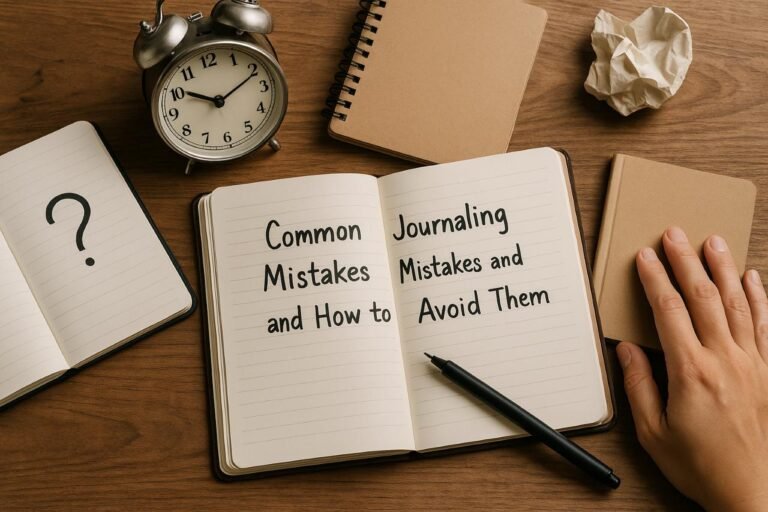Journaling is a transformative practice that promotes mindfulness, emotional clarity, and personal growth. However, many people unknowingly sabotage their journaling journey through common mistakes that hinder consistency, depth, and authenticity. Understanding these pitfalls and learning how to avoid them helps create a powerful journaling habit that supports mental health, creativity, and productivity. This guide covers the most frequent journaling errors, practical solutions, and effective techniques to enhance your writing experience.
Establish Clear Intentions Before You Write
The most common journaling mistake is writing without purpose. Many individuals start journaling with enthusiasm but quickly lose direction because they have not defined what they want to achieve. Without clear intent, your entries can feel repetitive or meaningless, making it difficult to stay motivated.
When you set an intention, such as improving emotional awareness, tracking habits, or reflecting on goals, you give structure and meaning to each session. Define your reason for journaling, whether it is emotional release, self-improvement, or creativity. This clarity turns journaling from random notes into a focused personal development tool.
Intentional journaling promotes alignment between your thoughts and objectives. Over time, it transforms chaotic mental chatter into organized insights, reinforcing self-awareness and progress tracking.
Identify Your Core Motivation
Ask yourself why you journal. Is it for stress relief, personal growth, gratitude, or problem-solving? Write this purpose at the top of your notebook or digital app to remind yourself before each session.
Create Goal-Based Prompts
Design prompts that align with your goals, such as “What emotion dominated my day?” or “What did I accomplish this week?” These help you write with direction and maintain engagement.
Avoid Writing Only When You Feel Inspired

Relying solely on inspiration to journal is a major mistake that prevents consistency. Waiting for the right mood turns journaling into an occasional activity rather than a sustainable habit.
Consistency builds the foundation for insight. By writing regularly, even when you do not feel inspired, you strengthen self-discipline and uncover subtle patterns in your emotions and thoughts. Regular journaling also normalizes reflection, helping you process daily experiences without judgment.
Inspiration should enhance your entries, not dictate them. Treat journaling like any healthy routine, something you show up for regardless of mood.
Establish a Journaling Routine
Choose a fixed time each day, such as before bed or after breakfast. Associating journaling with an existing habit helps make it automatic.
Use Low-Effort Entries on Busy Days
If you are tired or uninspired, write a single sentence, a gratitude list, or a brief thought summary. The key is showing up consistently.
Do Not Edit or Judge Your Entries While Writing
Perfectionism is one of the biggest journaling traps. Editing as you write interrupts the natural flow of thoughts, turning an emotional practice into a mechanical task. Journaling should capture raw emotion and honest reflection, not polished prose.
When you judge your words, you create resistance. This resistance blocks authenticity and limits emotional release. Remember that your journal is for you; it does not need to impress anyone.
Over time, this self-criticism can discourage you from journaling altogether. Allow your entries to be imperfect and unfiltered. Clarity will emerge naturally later.
Embrace Stream-of-Consciousness Writing
Write freely for five to ten minutes without stopping. Do not worry about grammar or spelling. The goal is expression, not precision.
Use a Separate Journal for Clarity Editing
If you want to refine insights later, keep a second reflection journal where you summarize and analyze what you wrote after a few days.
Maintain Focus Instead of Rambling Aimlessly

Another common mistake is letting entries drift without focus. While journaling should be flexible, excessive rambling can dilute meaning and make it hard to find insights later.
Writing with intention ensures each entry contributes to your growth. Focused journaling helps identify emotional triggers, recurring thoughts, and actionable lessons.
Lack of focus often stems from unclear prompts or a distracted mindset. Set boundaries for your topics and time limits to bring clarity and structure.
Use Guided Prompts
Select prompts based on themes such as gratitude, productivity, relationships, or emotions. Focus on one theme per entry to maintain direction.
Try the One-Topic Rule
Dedicate each journaling session to a single topic or question. This deepens your exploration and createsmore meaningful insights.
Include Reflection and Review Sessions
Many people write daily but never look back at their entries. This mistake prevents progress tracking and self-awareness development. Reflection is where transformation happens; it connects your past thoughts to present growth.
Regularly reviewing your journal helps identify patterns, emotional triggers, and achievements. It also reinforces your goals and reminds you how far you have come.
Reflection sessions transform your journal into a self-coaching tool. They bring awareness to unconscious habits and motivate improvement.
Schedule Monthly Reviews
Set aside time once a month to reread entries and highlight key lessons, emotions, and recurring themes.
Use Color Codes for Quick Insights
Create a color system such as blue for goals, green for gratitude, and red for challenges to visually organize your reflections.
Balance Emotional Release with Constructive Insight

Focusing solely on venting emotions can turn journaling into a repetitive cycle of frustration rather than healing. Emotional release is essential, but without reflection and solution-oriented thinking, it can reinforce negativity.
Balanced journaling includes both catharsis and growth. After expressing emotions, add a section for lessons learned or actions to take. This promotes emotional regulation and problem-solving.
By shifting from emotional dumping to constructive self-dialogue, you turn journaling into a powerful tool for personal evolution.
Add a Next Steps Section
End each entry with one positive takeaway or small action you can take to address the emotions or challenges you wrote about.
Practice Gratitude Integration
Include at least one gratitude statement per entry to shift focus from problems to appreciation, reinforcing emotional balance.
Common Mistakes vs. Effective Habits
| Common Mistake | Resulting Problem | Effective Habit | Positive Outcome |
| Writing without purpose | Lack of direction | Set clear intentions | Focused and meaningful entries |
| Journaling only when inspired | Inconsistency | Build daily routine | Sustainable habit |
| Editing while writing | Self-criticism | Stream-of-consciousness | Authentic expression |
| Rambling aimlessly | Loss of clarity | Use focused prompts | Insightful writing |
| Never reviewing entries | Missed growth | Schedule reflection | Measurable progress |
| Fear of exposure | Censorship | Ensure privacy | Honest journaling |
| Only emotional venting | Repeated negativity | Add constructive insight | Emotional resilience |
Journaling Frequency and Effectiveness
| Frequency | Typical Duration | Recommended Focus | Expected Benefit |
| Daily | 5–15 minutes | Emotional check-in | Improved mindfulness |
| Weekly | 20–30 minutes | Goal tracking | Enhanced productivity |
| Monthly | 30–60 minutes | Reflection and review | Deeper self-awareness |
| Occasional | Flexible | Creative expression | Stress relief |
Conclusion
Avoiding common journaling mistakes transforms a simple writing habit into a structured self-development practice. By journaling with intention, consistency, and authenticity, you build emotional intelligence and clarity. Review your progress, protect your privacy, and balance emotional release with constructive reflection. Over time, your journal becomes a trusted companion for personal growth, creativity, and self-understanding.
Explore more insightful and valuable content on our blog journalingtechniques! Stay updated with helpful tips, expert advice, and in-depth articles that enhance your knowledge.
FAQ’s
Consistency matters more than frequency. Aim for daily or weekly sessions to develop emotional awareness and clarity.
Early mornings or evenings are ideal, times when your mind is calm and reflective. Choose a schedule you can maintain.
Both work well. Handwriting promotes emotional processing, while digital journals offer convenience and privacy options.
Both work well. Handwriting promotes emotional processing, while digital journals offer convenience and privacy options.
Set specific goals, use prompts, and celebrate small milestones. Habit stacking, which links journaling to another daily activity, helps too.
Yes, but resume quickly to maintain momentum. Missing a day is not failure. Use flexibility as a motivator, not an excuse.
Journaling supports mental wellness but does not replace professional therapy. It can complement counseling by helping you articulate thoughts and emotions.

